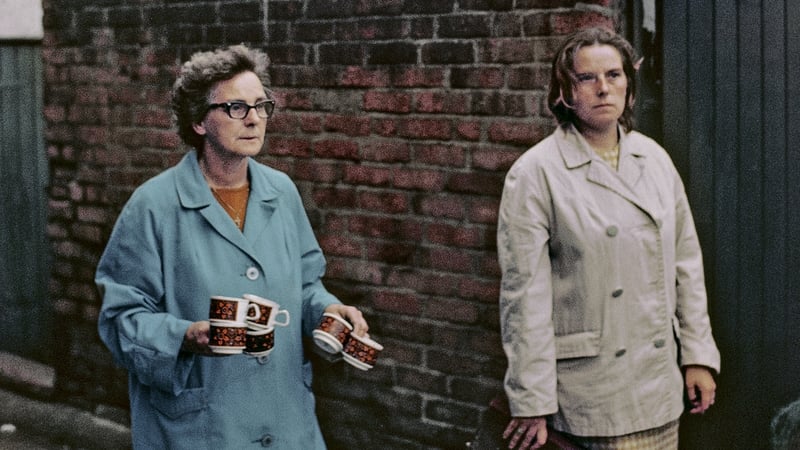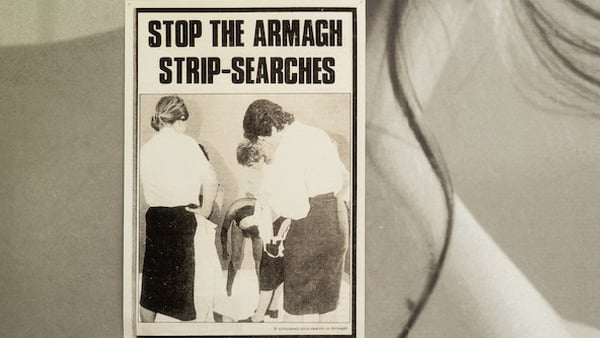From the late 1960s to the mid 1980s, acclaimed Japanese photographer Akihiko Okamura (1929-1985) lived in Ireland when he created a remarkable and largely unseen body of work.
Photo Museum Ireland are hosting the first solo exhibition of Okamura's work; the result of years of research and collaboration by an international team of historians, curators and publishers, the exhibition is accompanied by a photobook and documentary film on Okamura's Irish work.
Below, journalist Sean O'Hagan explores Akihiko Okamura 'haunting and haunted' images of The Troubles in Northern Ireland.
I first encountered Akihiko Okamura's work in 2016, when the British photographer Martin Parr included a handful of his photographs in a group show at the Barbican Centre in London entitled Strange and Familiar. For me, that unexpected encounter with his images of the early Troubles in Northern Ireland was revelatory. In their quiet observation and deep colour tones, they evoked a place I was once intimately familiar with but whose textures and characteristics had been blurred or buried by the passing of time. Suddenly, surprisingly, I was thrown back there.
We need your consent to load this rte-player contentWe use rte-player to manage extra content that can set cookies on your device and collect data about your activity. Please review their details and accept them to load the content.Manage Preferences
Listen: RTÉ Arena on the work of Akihiko Okamura
What was striking about Okamura's way of seeing was its complex merging of detachment and intimate observation, his outsider's eye illuminating the lingering everydayness of a place where normality had been abruptly fractured, and the ordinary upended. The result is a kind of deep looking that sidesteps the obvious and the overtly dramatic, and, in the process, signals the subjective documentary approach adopted by a generation of photographers who came of age a few generations later.
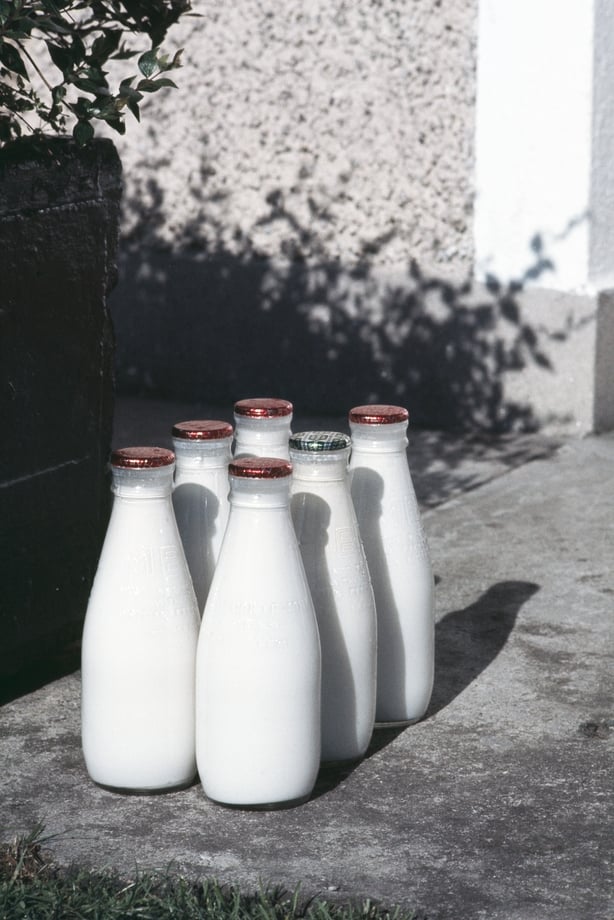
(© Estate of Akihiko Okamura / © 佐藤純子)
Consider Okamura's still lifes from that time. In the most seemingly mundane, six milk bottles - two neat rows of three - stand on sunlit concrete beneath a pebble-dashed wall. It appears, on the surface, a study of light, colour, shape and shadow, as well as a reminder of a time when milk was delivered to doorsteps daily across the island of Ireland. (In this instance five red-topped bottles of semi-skimmed and one green-topped bottle of skimmed milk.) For me, these innocuous-looking bottles are loaded, and not just with milk and nostalgic memories. In a related image, a more disordered arrangement of empty milk bottles carries a more ominous import. They stand beside a pile of stones on the ledge of a tower block overlooking a cityscape, the bottles having been repurposed as weapons to be used by nationalist youths in Derry against the Royal Ulster Constabulary (RUC), a police force that, in the fractious summer of 1969, was laying siege to their community.
In Okamura's photographs, context is crucial. He arrived in Northern Ireland at a pivotal moment in the province's contested history, when a series of peaceful civil rights marches by the nationalist minority had given way to a kind of scattered insurrection provoked by the increasingly violent response of the state towards the protestors. Okamura was present in Derry in mid-August 1969, when three days of intense street battles between the police and youths from the Bogside and Creggan housing estates culminated in a small victory for the locals, who famously proclaimed the area "Free Derry".
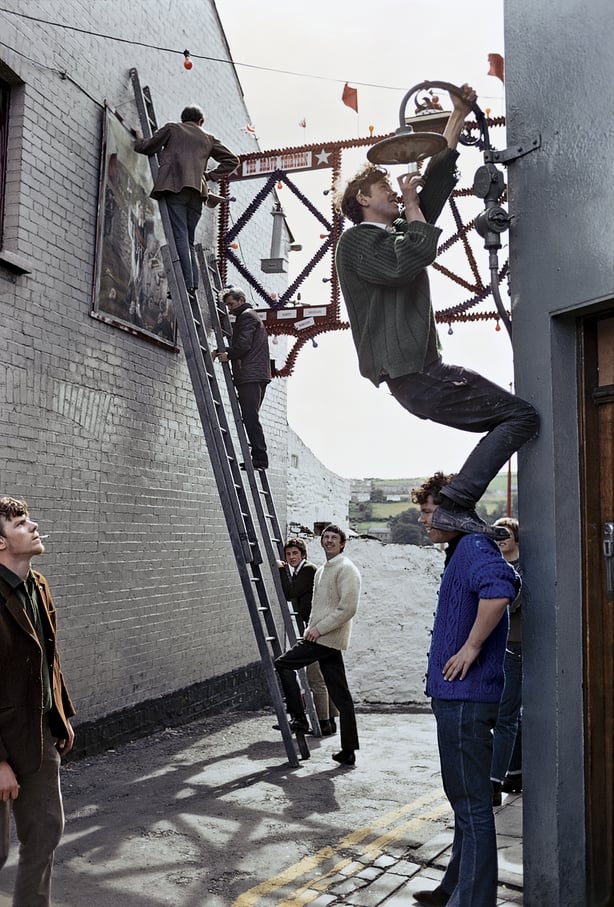
Derry city, Northern Ireland, c. 1969
(© Estate of Akihiko Okamura / © 佐藤純子)
The uprising ignited similar outbreaks of violent resistance in nationalist areas across the province. In Armagh, the housing estate on which I lived, briefly became a so-called no-go zone for the police, both entrances blocked by makeshift barricades defended by stone-throwing youths, their faces partially covered by handkerchiefs soaked in vinegar - an antidote to the clouds of tear gas that hung in the air. I remember it as a time of fear, excitement and risk, our ordinary lives suddenly buoyed by an almost dizzying sense of collective liberation.
The fear was felt most intensely on the tightly knit streets of Belfast. Okamura arrived there from Derry in time to witness the desolate fallout of the intense sectarian violence that had erupted in parts of the city when loyalist mobs, abetted by the police, attacked several Catholic neighbourhoods. Seven people were killed, hundreds wounded, and over 1,800 families were evacuated as entire streets were set on fire. From that moment, to paraphrase the Irish poet, William Butler Yeats, all was changed, changed utterly.
Like several other local and international photographers, then, Okamura was a witness to the cataclysmic events that marked the very beginning of the Troubles in Northern Ireland. While other more renowned photographers like Don McCullin and Gilles Peress worked in the eye of the storm, what sets Okamura apart is the way in which he responded to the outbreak of sudden social upheaval, not as a photojournalist as he had been in Vietnam in the preceding years, but as a detached and democratic observer alert to the myriad human dramas that resulted. Okamura's gaze, and indeed his consciousness, seems to have been altered as a result of his experiences as a war photographer, becoming more reflective, more glancing.
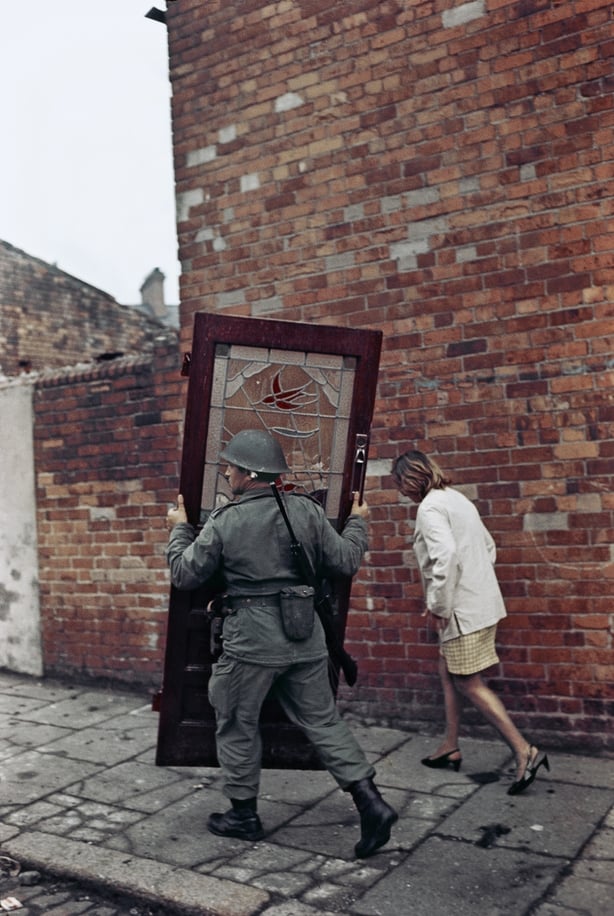
West Belfast, Northern Ireland, 1969
(© Estate of Akihiko Okamura / © 佐藤純子)
As a result, there is often a calmness to his images from that uncertain and unruly time in Northern Ireland, his eye often drawn to tableaux in which the violence is suggested rather than spelt out. A case in point is his deftly composed street scene in which a soldier carries a woman's ornate front door down a red-bricked street as she walks purposefully beside him. Like several of his photographs from the time, this was made in the wake of terrible violence and the curious viewer must look to other related photographs by him for illumination. They show dazed women standing beside domestic furniture and humble possessions salvaged from sectarian arson attacks on their homes.
These, like his stark photograph of a blood-stained pavement on which flowers have been placed beneath a black flag, are aftermath images in which the panic and horror of sectarian mob violence has already happened, but the traces of it linger like ash in the air. Though left-wing in his politics and sympathies, Okamura was remarkably democratic and even-handed in his approach.
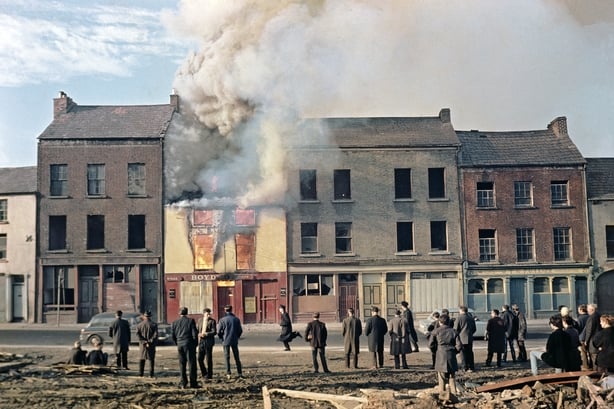
(© Estate of Akihiko Okamura / © 佐藤純子)
He homed in on local leaders like the young civil rights icon Bernadette Devlin and the firebrand loyalist preacher and politician Rev. Ian Paisley, but also cheerful young men hanging red, white and blue bunting across streets in Protestant neighbourhoods and anonymous citizens lost in moments of quiet reverie while Orange marches pass them by. In one almost playful tableau, he captures a group of newly arrived soldiers sitting, exhausted looking but cheerful, on a pavement beneath a billboard advertising Player's cigarettes. The dismal, litter-strewn streets are a world away from the dazzlingly unreal sandy beach on which two tanned and windswept young men and a beautiful woman pose on horses.
Okamura also trained his camera on soldiers patrolling ominously unfamiliar city streets, their gazes searching or alert.Though ostensibly British, Northern Ireland had a sizeable population that viewed the troops as an occupying force, who were often feared, sometimes hated, always regarded with deep suspicion. By homing in, and isolating, an individual on a foot patrol, Okamura amplified the subject's sense of otherness and insecurity in an unfamiliar urban landscape where the sense of threat was constant.
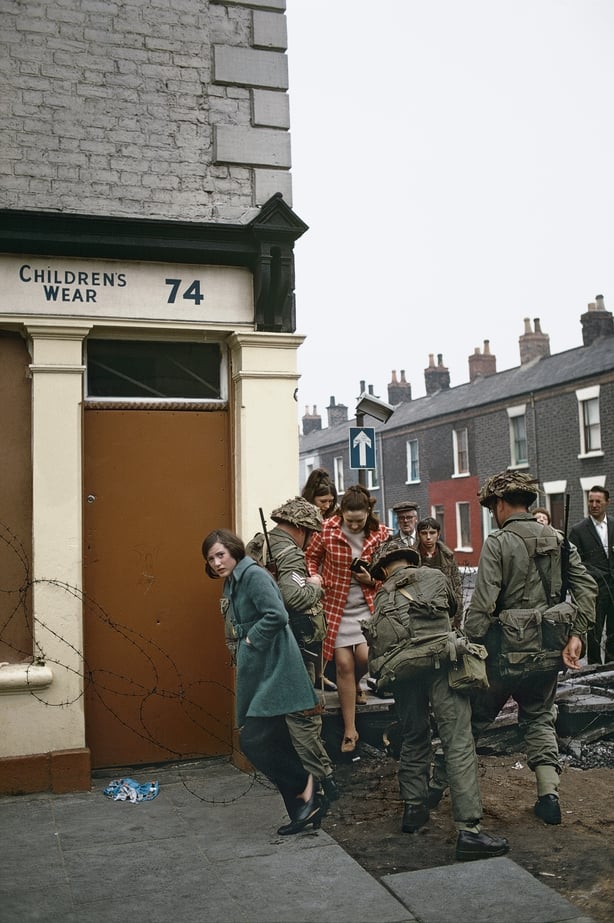
(© Estate of Akihiko Okamura / ©佐藤純子)
Here and there, too, his street portraits possess the artfully choreographed quality of film stills. In one, a soldier stands dramatically poised as if for imminent battle on a street corner, baton and shield at the ready. In another - one of the few photographs he made of an actual riot - a phalanx of soldiers stand behind a row of tall shields on a street littered with stones while, in the background, onlookers gaze from windows and doorsteps. This may be one of the first images made of a peculiarly Northern Irish phenomenon: rioting as a spectator sport for bored or curious locals.
Back then, though, Belfast and Derry were cities whose working-class streets had begun to resemble war zones. Another small series shows local women negotiating the various barriers that suddenly interrupted their daily routines. In one, a young woman glances at Okamura as she passes through a group of soldiers who are helping her friend climb over a street barricade made of barbed wire, upended paving stones and scrap metal.
Here, too, a small crowd of onlookers watch this small drama unfold as they wait, their curiosity another signifier of a disrupted everyday that would soon become normalised.
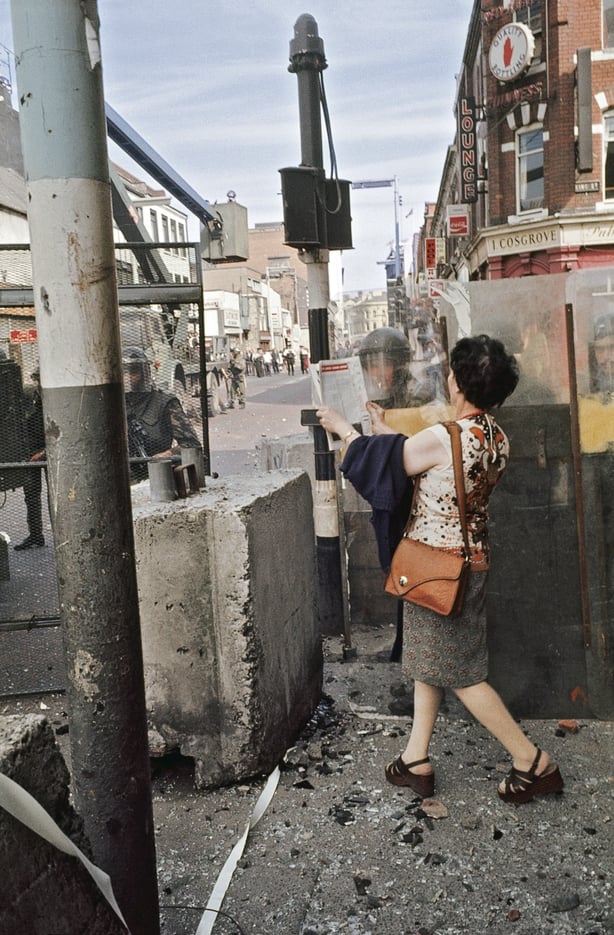
(© Estate of Akihiko Okamura / © 佐藤純子)
My own gaze, steeped in memory, keeps returning to those milk bottles and to the other singular still lifes Okamura made at that time. In one, an upright military riot shield rests against a wall behind a container on which a protective helmet and visor sits atop a thermos flask and a lunch box. Here, the martial and the mundane coexist in a sculptural readymade that is brimful of the kind of acutely revealing details that Roland Barthes called "punctums". Inside the opaque lunch box, the blurred outline of a pack of McVitie's biscuits, a staple Northern Irish snack, is perhaps the most resonant.
In another oddly artful tableau from that troubled time, two young girls in their Sunday clothes - bonnets, smart dresses, white knee-length socks and shiny shoes - cradle handbags as they stand beside a makeshift shrine on a Derry street. As viewers from across a distance of several decades, our curiosity is an echo of their own, while the object of their childlike attention, an impromptu memorial to one of the earliest victims of the conflict, remains intriguing, not least in its religious symbolism.

where Desmond Beattie (19 years old) was shot and killed on 8 July 1971
by the British Army. Seamus Cusack (28 years old) was shot dead near
this spot about twelve hours later. These men were the first
people shot dead by the British Army in Derry.
(© Estate of Akihiko Okamura / © 佐藤純子)
There is a poignancy to this image as there is to several Okamura photographs from this time. They suggest a sense of innocence lost and history hanging in the balance, as well as foreshadowing the long dark years of violence and death yet to come. In all of this, Okamura himself remains an elusive presence.
There is a single sighting of him, standing near the activist and MP Bernadette Devlin, in a photograph taken in Derry by a local man, Barney McMonagle, yet no one from that tumultuous time seems to remember meeting him. How his apparent anonymity was achieved lends another layer of mystery to his personality and his photographic process. I imagine him wandering the uneasy streets of Derry and Belfast, an almost clandestine presence trying not to draw too much attention to himself. Or his camera. Or his otherness.
Back then, Northern Ireland, perhaps even more so than the rest of the island, was a monocultural place. I doubt that many of the people he mingled with would have encountered a Japanese person in the flesh before. Yet he seems to have moved easily among them, albeit leaving little trace that he was there other than his photographs. In her illuminating text for this book, his daughter Kusi compares him to a ghost, an invisible witness, "never seen, never spoken to, never heard". Perhaps we should not be surprised, then, by the enduring aura of his evocative images of a troubled land that he saw with a stranger's distant, but acutely observant, eye. They remain haunting and haunted, their quiet power undiminished by the passing years.
About the author: Sean O'Hagan is a writer for The Guardian and The Observer.
Akihiko Okamura - The Memories of Others is at Photo Museum Ireland until 6th July 2024 - find out more here.
This essay is taken from The Memories of Others – Photobook (Atelier EXB/Prestel), a new volume accompanying the exhibition, edited by Pauline Vermare and also featuring essays by Pauline Vermare and Masako Toda, plus texts by Kusi Okamura and Trish Lambe.
